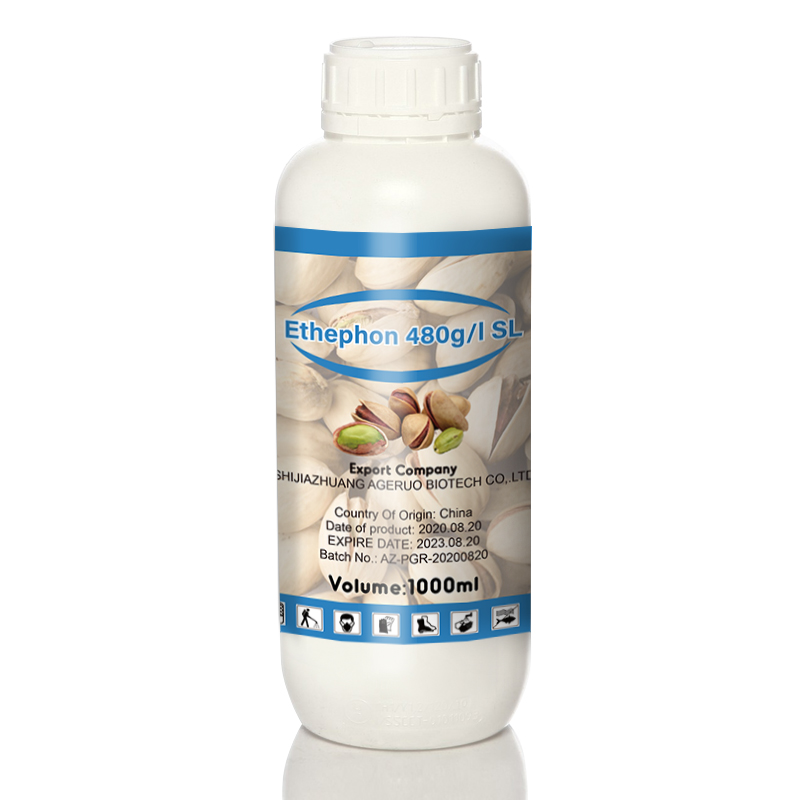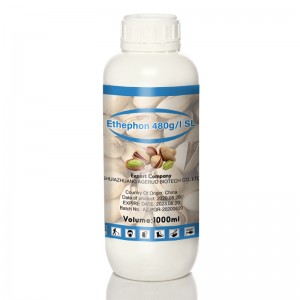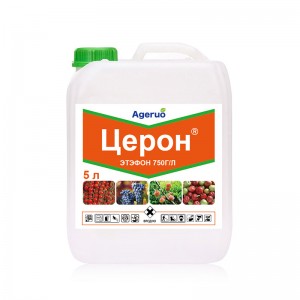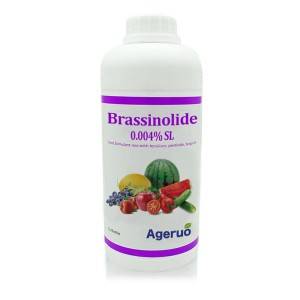Products
POMAIS Chemical Regulator Ethephon 480g/l SL 40% SL
Introduction
Ethephon is a maturation-promoting plant growth regulator. Ethylene enters the plant through the leaves, bark, fruit or seeds of the plant, and then conducts to the working part, releasing ethylene, which can act as the endogenous hormone ethylene. Its physiological functions, such as promoting fruit ripening and shedding of leaves and fruits, dwarfing plants, changing the ratio of male and female flowers, inducing male sterility in some crops, etc.
| Active ingredients | Ethephon 480g/l SL |
| CAS Number | 16672-87-0 |
| Molecular Formula | C2H6ClO3P |
| Application | plant growth regulator |
| Brand Name | POMAIS |
| Shelf life | 2 years |
| Purity | 480g/l SL; 40% SL |
| State | Liquid |
| Label | POMAIS or Customized |
| Formulations | 480g/l SL; 85% SP; 20% GR; 54% SL |
| The mixed formulation product | Ethephon 27% AS (corn) + DA-6(Diethylaminoethyl hexanoate)3%
Ethephon 9.5% + Naphthalene acetic acid 0.5% SC Ethephon 40%+thidiazuron10% SC Ethephon 40%+Thidiazuron 18% + diuron7% SC |
Mode of Action
Ethephon enters the plant through the leaves, fruits and seeds of the plant, and is transmitted to the action site to release ethylene, which can promote fruit ripening, leaf and fruit shedding, dwarf plants, and change male and female flowers. ratio, induce male sterility in certain crops, etc.
Suitable crops:
Ethephon is registered for use on a number of food, feed and nonfood crops, greenhouse nursery stock, and outdoor residential ornamental plants, but is used primarily on cotton.

Using Method
| Formulation | Plant | Effect | Usage | Method |
|
480g/l SL; 40% SL |
Cotton | Ripen | 4500-6000/ha times liquid | Spray |
| Tomatto/Rice | Ripen | 12000-15000/ha times liquid | Spray | |
| 54% SL | Rubber | Increase production | 0.12-0.16ml/plant | Smear |
| 20% GR | Banana | Ripen | 50-70 mg/kg fruit | Airtight fumigation |
Method: Ethephon is typically applied as a foliar spray. The specific dosage and timing depend on the crop, the desired effect, and the environmental conditions.
Safety Measures: Proper protective equipment should be used to avoid direct contact with the skin and eyes. Applicators should follow the recommended guidelines for handling and usage.
Precautions:
Phytotoxicity: Over-application or improper timing can lead to plant stress or damage. It's important to adhere strictly to recommended application rates.
Environmental Impact: As with any agrochemical, responsible use is essential to minimize environmental contamination. Avoid application near water bodies and follow local regulations.
Residue Management: Ensure that the application complies with the pre-harvest interval to avoid excessive residue levels in the produce.
Uses
Ethephon is absorbed by plant tissues and then converted into ethylene, a natural plant hormone. This ethylene release regulates various physiological processes in plants. Ethephon is employed in a variety of crops for different purposes, including:
Fruit Ripening: It promotes uniform ripening of fruits such as tomatoes, apples, pineapples, and bananas.
Flower Induction: Used to induce flowering in pineapples.
Harvest Aid: Facilitates easier harvesting of crops like cotton by promoting boll opening.
Growth Regulation: Helps in controlling plant height in ornamental plants and cereals by reducing internode elongation.
Breaking Dormancy: Assists in breaking the dormancy of buds in certain crops like grapes and tubers.
Increasing Latex Flow: Used in rubber trees to enhance latex production.
Benefits
Uniform Ripening: Ensures consistent color and quality in fruits, improving marketability.
Enhanced Harvest Efficiency: By promoting uniform maturation, ethephon aids in synchronized harvesting, which can reduce labor costs and improve yield.
Growth Control: Helps manage plant height and structure, which is particularly useful in dense planting systems to improve light penetration and reduce lodging.
Induction of Flowering: Allows for better scheduling of flowering and fruit set, improving overall crop management.
Improved Latex Yield: In rubber trees, it can significantly boost latex output, enhancing productivity.
FAQ
How to get a quote?
Please click 'Leave Your Message' to inform you of the product, content, packaging requirements and quantity you are interested in, and our staff will quote you as soon as possible.
What about the payment terms?
30% in advance, 70% before shipment by T/T.
Could you provide some free sample?
Most samples of less than 100g can be provided for free, but will add extra cost and shipping cost by courier.
Why Choose US
1. Strict quality control procedure in each period of order and the third-party quality inspection.
2. Have cooperated with importers and distributors from 56 countries all over the world for ten years and maintain a good and long-term cooperative relationship.
3. Strictly control the production progress and ensure the delivery time.
Within 3 days to confirm the package details,15 days to produce package materials and purchase products raw material,5 days to finish packaging, one day showing pictures to clients, 3-5days delivery from factory to shipping ports.
















